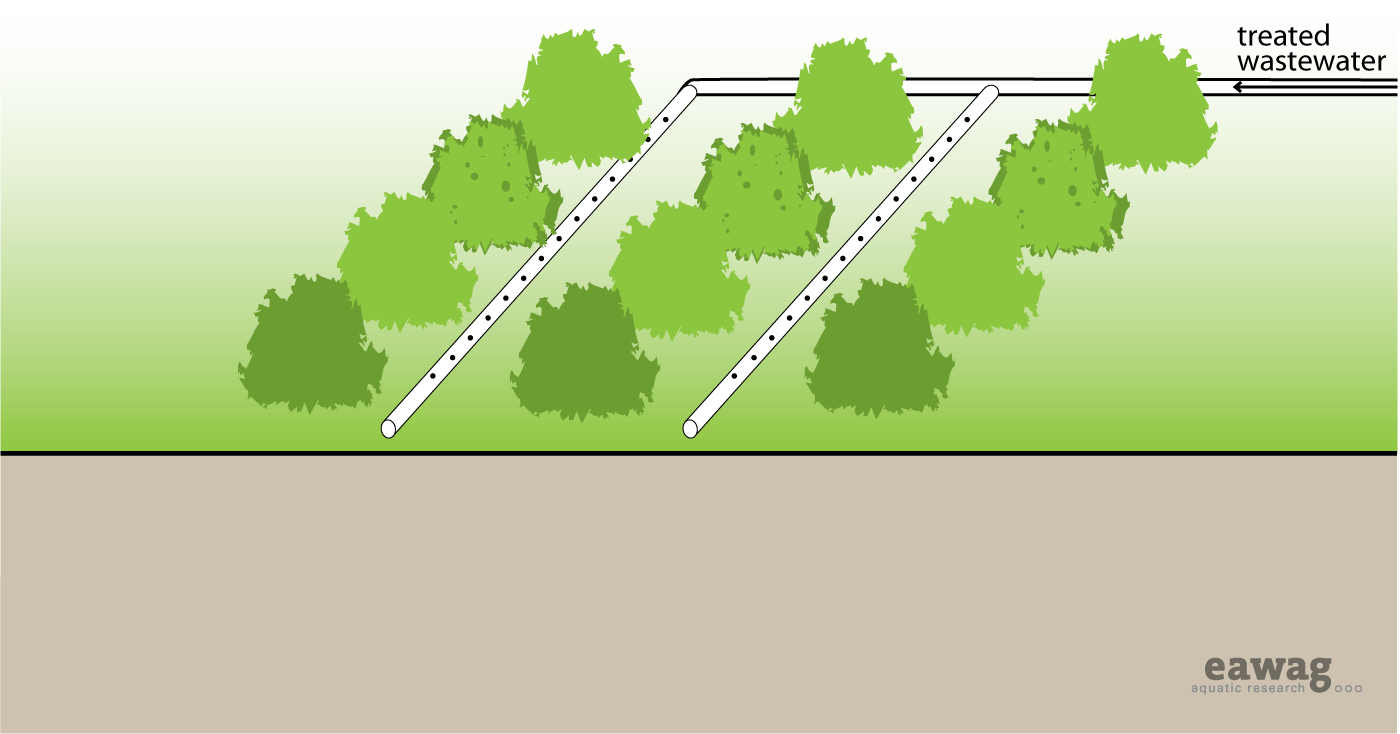Irrigation
|
|
|||||||||||||||||||||||||||
To reduce dependence on freshwater and maintain a constant source of water for irrigation throughout the year, wastewater of varying quality can be used in agriculture. However, only water that has had secondary treatment (i.e., physical and biological treatment) should be used to limit the risk of crop contamination and health risks to workers.
There are two kinds of irrigation technologies appropriate for treated wastewater: 1) Drip irrigation above or below ground, where the water is slowly dripped on or near the root area; and 2) Surface water irrigation where water is routed overland in a series of dug channels or furrows. To minimize evaporation and contact with pathogens, spray irrigation should be avoided. Properly treated wastewater can significantly reduce dependence on freshwater, and/or improve crop yields by supplying increased water and nutrients to plants. Raw sewage or untreated blackwater should not be used, and even well-treated water should be used with caution. Long-term use of poorly or improperly treated water may cause long-term damage to the soil structure and its ability to hold water.
Contents
[hide]Design Considerations
The application rate must be appropriate for the soil, crop and climate, or it could be damaging. To increase the nutrient value, urine can be dosed into irrigation water; this is called “fertigation” (i.e., fertilization + irrigation). The dilution ratio has to be adapted to the special needs and resistance of the crop. In drip irrigation systems care should be taken to ensure that there is sufficient head (i.e., pressure) and maintenance to reduce the potential for clogging (especially, with urine from which struvite will spontaneously precipitate).
| Advantages | Disadvantages/limitations |
|---|---|
| - Reduces depletion of groundwater and improves the availability of drinking water - Reduces the need for fertilizer |
- May require expert design and installation - Not all parts and materials may be locally available |
Appropriateness
Generally, drip irrigation is the most appropriate irrigation method; it is especially good for arid and drought prone areas. Surface irrigation is prone to large losses from evaporation but requires little or no infrastructure and may be appropriate in some situations.
Crops such as corn, alfalfa (and other feed), fibres (e.g., cotton), trees, tobacco, fruit trees (e.g., mangos) and foods requiring processing (e.g., sugar beets) can be grown safely with treated effluent. More care should be taken with fruits and vegetables that may be eaten raw (e.g., tomatoes) because they could come in contact with the water. Energy crops like eucalyptus, poplar, willow, or ash trees can be grown in short-rotation and harvested for biofuel production. Since the trees are not for consumption, this is a safe, efficient way of using lower-quality effluent. Soil quality can degrade over time (e.g., due to the accumulation of salts) if poorly treated wastewater is applied. Despite safety concerns, irrigation with effluent is an effective way to recycle nutrients and water.
Health Aspects/Acceptance
Appropriate treatment (i.e., adequate pathogen reduction) should precede any irrigation scheme to limit health risks to those who come in contact with the water. Furthermore, it may still be contaminated with the different chemicals that are discharged into the system depending on the degree of treatment the effluent has undergone. When effluent is used for irrigation, households and industries connected to the system should be made aware of the products that are and are not appropriate to discharge into the system. Drip irrigation is the only type of irrigation that should be used with edible crops, and even then, care should be taken to prevent workers and harvested crops from coming in contact with the treated effluent. The WHO guidelines on wastewater use in agriculture should be consulted for detailed information and specific guidance.
Operation & Maintenance
Drip irrigation systems must be periodically flushed to avoid biofilm growth and clogging from all types of solids. Pipes should be checked for leaks as they are prone to damage from rodents and humans. Drip irrigation is more costly than conventional irrigation, but offers improved yields and decreased water/operating costs. Workers should wear appropriate protective clothing.
References
- Drechsel, P., Scott, C. A., Raschid-Sally, L., Redwood, M. and Bahri, A. (Eds.) (2010). Wastewater Irrigation and Health. Assessing and Mitigating Risk in Low-Income Countries. Earthscan, IDRC and IWMI, London, UK.
- FAO (2012). On-Farm Practices for the Safe Use of Wastewater in Urban and Peri-Urban Horticulture. A Training Handbook for Farmer Field Schools. FAO, Rome, IT.
- Palada, M., Bhattarai, S., Wu, D., Roberts, M., Bhattarai, M., Kimsan, R. and Midmore, D. (2011). More Crop Per Drop. Using Simple Drip Irrigation Systems for Small-Scale Vegetable Production. The World Vegetable Center, Shanhua, TW.
- Pescod, M. B. (1992). Wastewater Treatment and Use in Agriculture. FAO Irrigation and Drainage Paper 47. FAO, Rome, IT.
- WHO (2006). Guidelines for the Safe Use of Wastewater, Excreta and Greywater. Volume 2: Wastewater Use in Agriculture. World Health Organization, Geneva, CH. (Discussion of health aspects of wastewater use and of good irrigation practice in Annex 1)
- Winpenny, J., Heinz, I. and Koo-Oshima, S. (2010). The Wealth of Waste. The Economics of Wastewater Use in Agriculture. FAO Water Reports 35. FAO, Rome, IT
- Zandee, M. (2012). Risk of Clogging of Drip-Line Emitters during Urine Fertilization through Drip Irrigation Equipment. Eawag, Dübendorf, CH.
Acknowledgements
The material on this page was adapted from:
Elizabeth Tilley, Lukas Ulrich, Christoph Lüthi, Philippe Reymond and Christian Zurbrügg (2014). Compendium of Sanitation Systems and Technologies, published by Sandec, the Department of Water and Sanitation in Developing Countries of Eawag, the Swiss Federal Institute of Aquatic Science and Technology, Dübendorf, Switzerland.
The 2nd edition publication is available in English. French and Spanish are yet to come.


